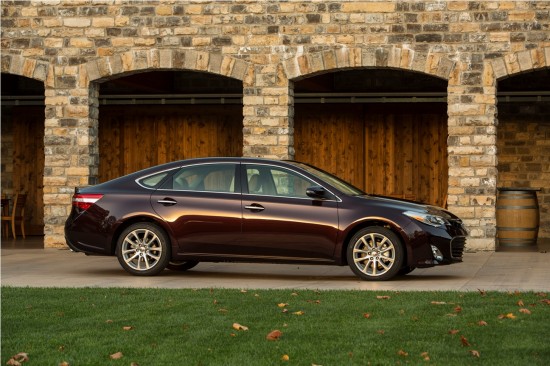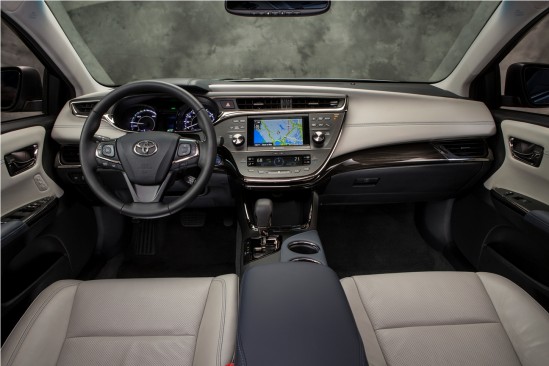First Drive: 2013 Toyota Avalon
Going Places
I think we can all agree that the last iteration of the Toyota Avalon was in need of a double dose of espresso. So when I was invited recently to drive the all-new 2013 Avalon, my first thought was to caffeine up before I settled behind the wheel. What I expected to be little more than weak coffee turned out to be more like a caffe vanilla Frappuccino. Let me explain.
The current median age of Avalon consumer is 60. This is because Avalons of the past were cushy and roomy and, honestly, very bland to look at. They didn’t offend anyone but they weren’t icons of inspiration either. The Avalon is the car your grandparents drive and lately the 50-something crowd has been saying “interesting, but what else you got?” They are likely cross shopping the Avalon against the Ford Taurus, Hyundai Azera, or even a Buick LaCrosse. These products offer bold styling, a comfortable setting and by comparison, a fair amount more adrenaline. Toyota’s aim then with this generation of Avalon is to put a little more fire in the belly. Not abandon the typical Avalon consumer but rather draw the attention of younger buyers.
The new Avalon will come in two basic forms: V6 or Hybrid. Avalon V6 models come equipped with the tried-and-true 3.5L DOHC V6, a carryover from the previous generation. Nevertheless there is 268 hp on tap and 248 lb-ft of torque awaiting the beckoning call of your right foot all the while earning a 21 mpg city / 31 mpg hwy EPA rating. The hybrid model actually uses the identical Synergy Drive powertrain as the Camry. This means there is a 2.5L 4-cylinder coupled to a 105 kW AC Synchronous motor residing under the hood. This setup is good for a net 200 hp, but more importantly, a 40 mpg city / 39 mpg hwy EPA rating. While the Hybrid makes do with a CVT the V6 utilizes a conventional 6-speed auto equipped with paddle shifters (because everyone has these nowadays) on the upper XLE and Limited models.
The problem with bold styling is that you start to wander into the realm of love it or hate it. I don’t think Toyota is quite there with this car, but getting close. Quite frankly I am not a huge fan of the front end of this Avalon. That large lower grille is just very hard to stomach, just as it is on the Hyundai Sonata Hybrid. That said I get what they were going for and if you could pry your stare away from that gaping maw the lighting elements are actually quite attractive to look at with their square projector lenses and LED tracks.
Actually, just about every other angle of the car is fairly attractive. The profile view of the car is best to observe the very dramatic rake of the backlight into the rear deck lid (thank you Mercedes-Benz CLS for making that look so popular). The result of which is a true 6-window greenhouse and some fairly strong looking D-pillars. My favorite view is the rear-3/4 angle. It’s the one view of the car where all the body creases and character lines all come together harmoniously. The car sits well on its wheels, it looks composed, no doubt in part because the designers trimmed the front overhang by a half-inch, the rear overhang by one and a half and the roof line by an inch. Plenty of aerodynamic tuning went into the design work as well, yielding a very low Cd of 0.28 for both the Hybrid and V6 models.
There is even more to look at and enjoy on the inside. For starters the driver is rewarded with a thickly padded steering wheel wrapped in a rather top notch hide of leather. The seats are very comfortable and there really isn’t a surface inside that isn’t either pleasing to the eye or the touch; and that holds true for every trim level. In addition to the seats and steering wheel, leather adorns the dash, center console, armrests, etc. In Hybrid models the armrests and center console feature blue leather and blue stitching accents adorn the rest of the cabin. Switch gear layout is logical and actually spaced out so that you don’t have buttons on top of buttons. This creates what seems like a massive center stack, but it works. It also has a neat kind of floating appearance with the way the designers fit all the pieces together. Note too that a lot of the switchgear is capacitive, but in my opinion Toyota has set the benchmark here for capacitive buttons. Unlike in other examples (cough Chevrolet Volt cough) you get instant haptic feedback and they actually work quite well.
One disappointing aspect of the interior, however, is the placement of the drive mode selection buttons. Located on the center console just aft of the shifter are the buttons to toggle the driving experience between Normal, Sport, ECO and in the case of the hybrid: EV Mode. And maybe my short-legged close-to-the-steering-wheel seating position is to blame, but these key driving experience buttons were just a bit awkward of a reach.
This leads us to the driving experience. The start-up sequence should go something like this: start car, engage Sport mode, drive. I was pleasantly surprised by the effort focused on the driving dynamics of the Avalon, and I’m not talking about the V6 model only. We had the opportunity to sample both the Avalon Hybrid and V6 models and when push comes to shove (or an entertaining 45 mph sweeping corner presents itself) the cars will reward the driver with a fair amount of feedback and cornering aptitude. That is while they are in Sport mode, mind you. Attempt to take said corner while in Normal driving configuration or gasp…ECO…and there really is no telling what to expect. What it comes down to is communication and throttle response. Hit the Sport mode button and the electric power steering boost is dialed way back while throttle response is improved by 20%. The front tires talk to you so that you know what they are doing and know just how much more you can push them. In Normal or ECO modes the steering is lifeless, the only sense you can rely on there is sight. That said, the Avalon caters well to the demographic Toyota is attempting to reach.
There really isn’t a bad seat in the house. The interior is a comfortable roomy place to perch for an extended drive. Front seats are heated and cooled and adjust a thousand different ways (ok, we exaggerate, but you get the idea). The rear outboard seating positions are heated as well and while that sloping roofline suggests a low ceiling it’s actually quite useable. In terms of legroom only the tallest clientele will be wanting. With the front seat in full back position my 5’9” frame had plenty of room to stretch out and then some.
In summary, Toyota has a great car on their hands with the new Avalon. It’s packed with amenities, offers a solid pair of tried-and-true powertrains, and can be somewhat nimble on its feet when called upon. The styling certainly moves the Avalon away from the forgettable, but does it move it to desirable is the question. Only you can answer that, but regardless, the 2013 Toyota Avalon tastes better than its predecessors, and that’s kinda the point.
Pricing
Avalon V6
XLE $30,990
XLE Premium $33,195
XLE Touring $35,500
Limited $39,650
Avalon Hybrid
XLE Premium $35,555
XLE Touring $37,250
Limited $41,400
Photos courtesy of Toyota





























